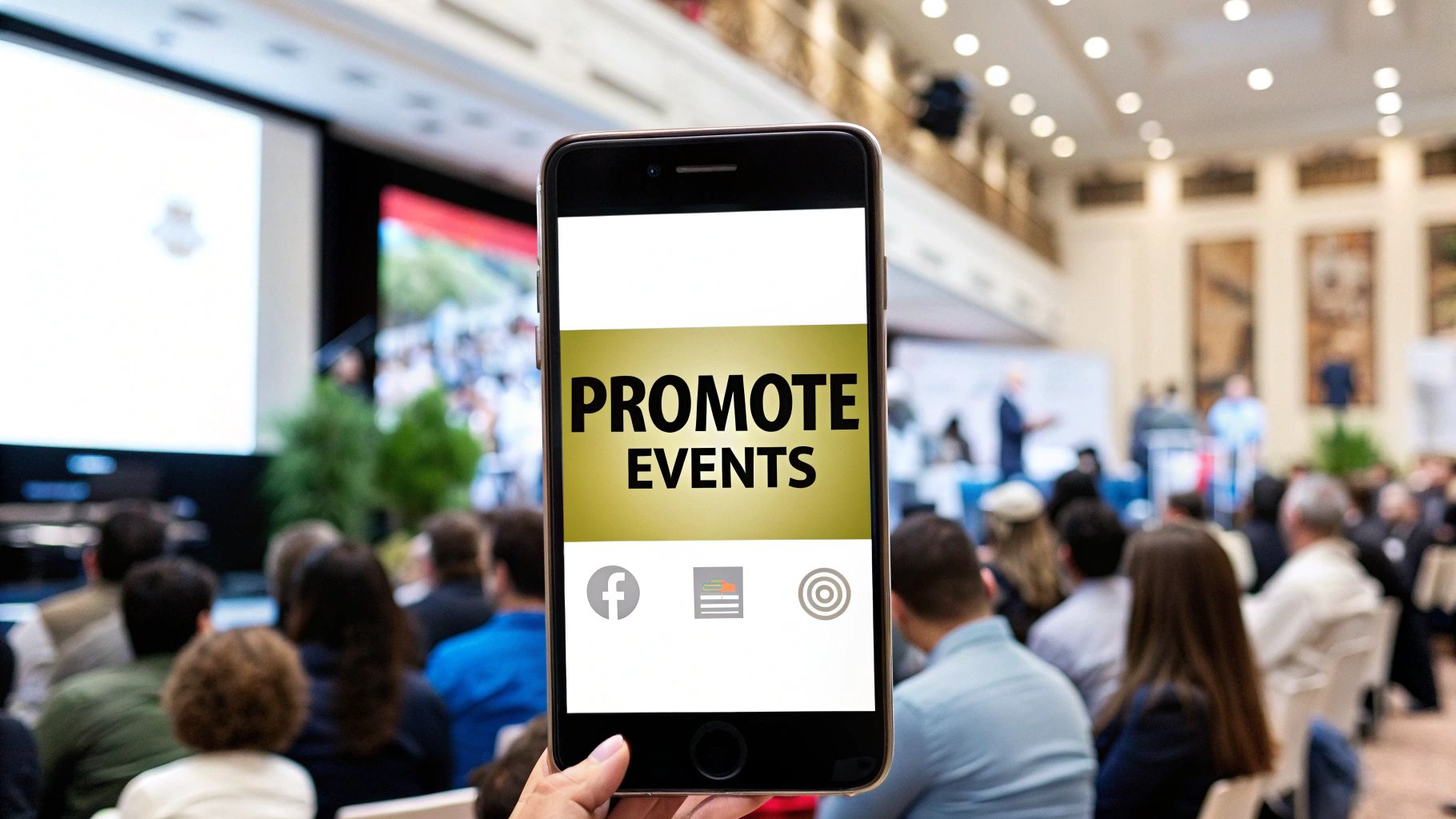
How to Promote Events to Maximize Your Attendance
Learn how to promote events with our complete guide. Discover proven digital and offline strategies to boost attendance and make your next event a success.
Table of Contents
A great event promotion strategy is more than just a marketing plan—it's about creating an experience. You need a mix of smart digital marketing, genuine community building, and some clever offline tactics to really get people excited. The goal is to build that buzz early on, keep people engaged everywhere they hang out online, and carry that energy all the way to event day and beyond.
Why Smart Event Promotion Is Your Biggest Asset
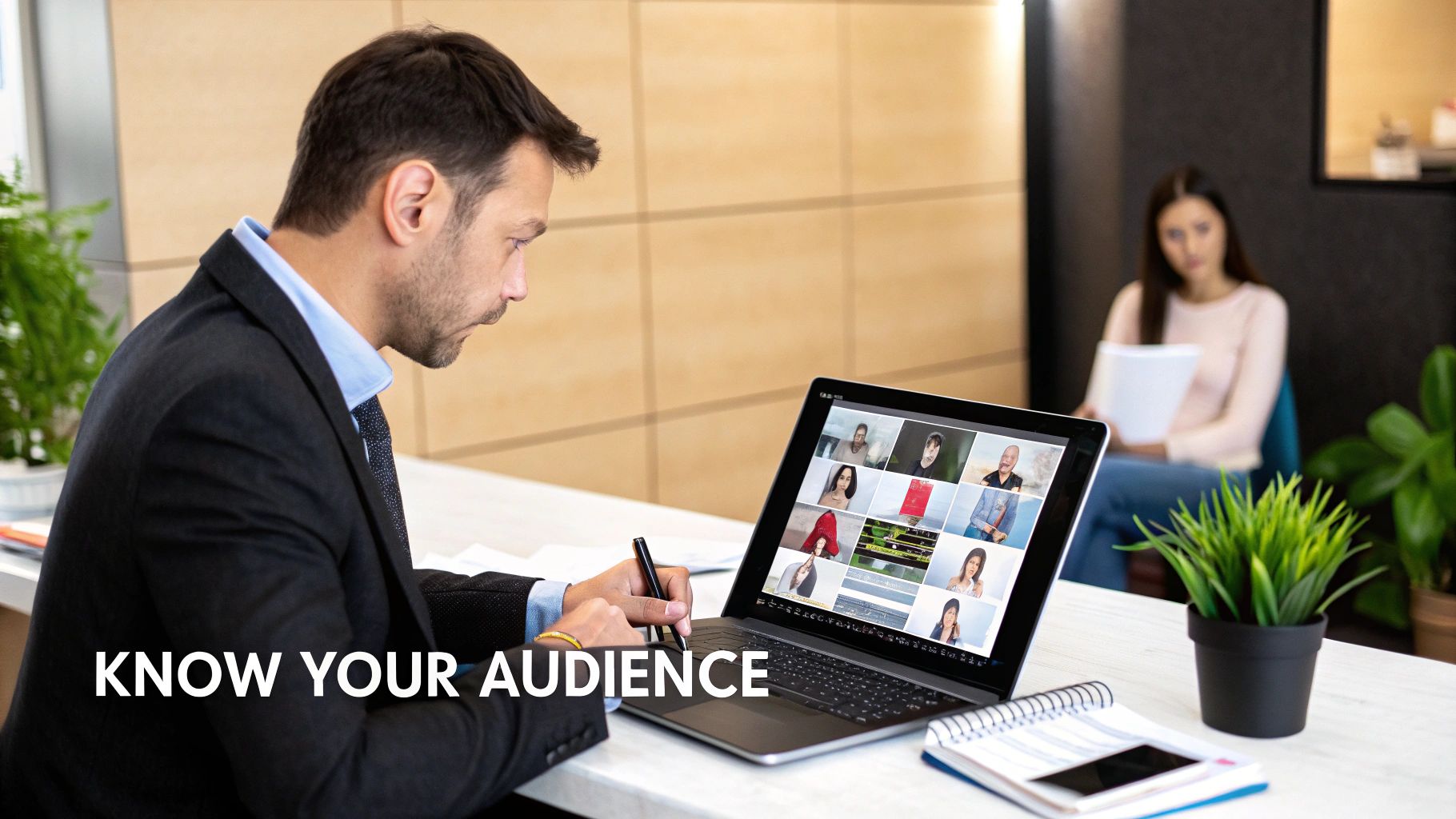
You can plan the most incredible event in the world, but if nobody shows up, it's just a great idea. Smart promotion is what connects that vision to a room full of people, turning your hard work into a memorable success. It’s not just about selling tickets; it’s about creating a community and generating a buzz that sticks around long after the event is over.
The event industry is booming, projected to hit a massive $2.5 trillion by 2035. On top of that, 74% of marketers expect their event budgets to go up in 2025. This tells us one thing: events work. When over two-thirds of attendees say they feel more connected to a brand after an event, your promotional efforts become a direct investment in building real loyalty.
The Modern Promotional Journey
Promoting an event today is less of a checklist and more of a journey. You can't just follow a generic script. A truly successful campaign pulls together a lot of different pieces to create one seamless experience for your audience.
Here's a look at the entire promotional lifecycle we're going to break down:
- Building Pre-Launch Buzz: It all starts with the basics. We'll cover creating a landing page that actually converts and figuring out exactly who you're trying to reach.
- Mastering Digital Channels: Your online game has to be strong. This means everything from engaging social media posts to strategic email campaigns. If you're using video, visuals are everything—these YouTube thumbnail design tips can help your content stand out.
- Deploying Creative Tactics: We’ll dive into a mix of digital and real-world strategies that grab attention and get people to act, making sure your event is the one they can't stop talking about.
Think of this as your practical roadmap. It’s not just about filling seats, but about building a vibrant community around your event and making a real impact.
Building Your Pre-Launch Promotion Strategy
Great event promotion doesn't just happen with a last-minute social media blast. The real magic begins long before you even think about hitting "publish." This pre-launch phase is all about laying a solid groundwork, turning a simple event idea into something people are genuinely excited about.
It all starts with getting laser-focused on who you're trying to reach and what you want to say to them.
Defining Your Audience and Message
Before you write a single line of copy, you have to get inside the head of your ideal attendee. Forget basic demographics for a moment. What really drives them? Are they a startup founder desperate for networking? A junior developer hungry for new skills?
Knowing their specific motivations and pain points is everything. It's the difference between a message that falls flat and one that makes them feel like you're speaking directly to them.
This infographic really nails down the process of crafting that perfect message.
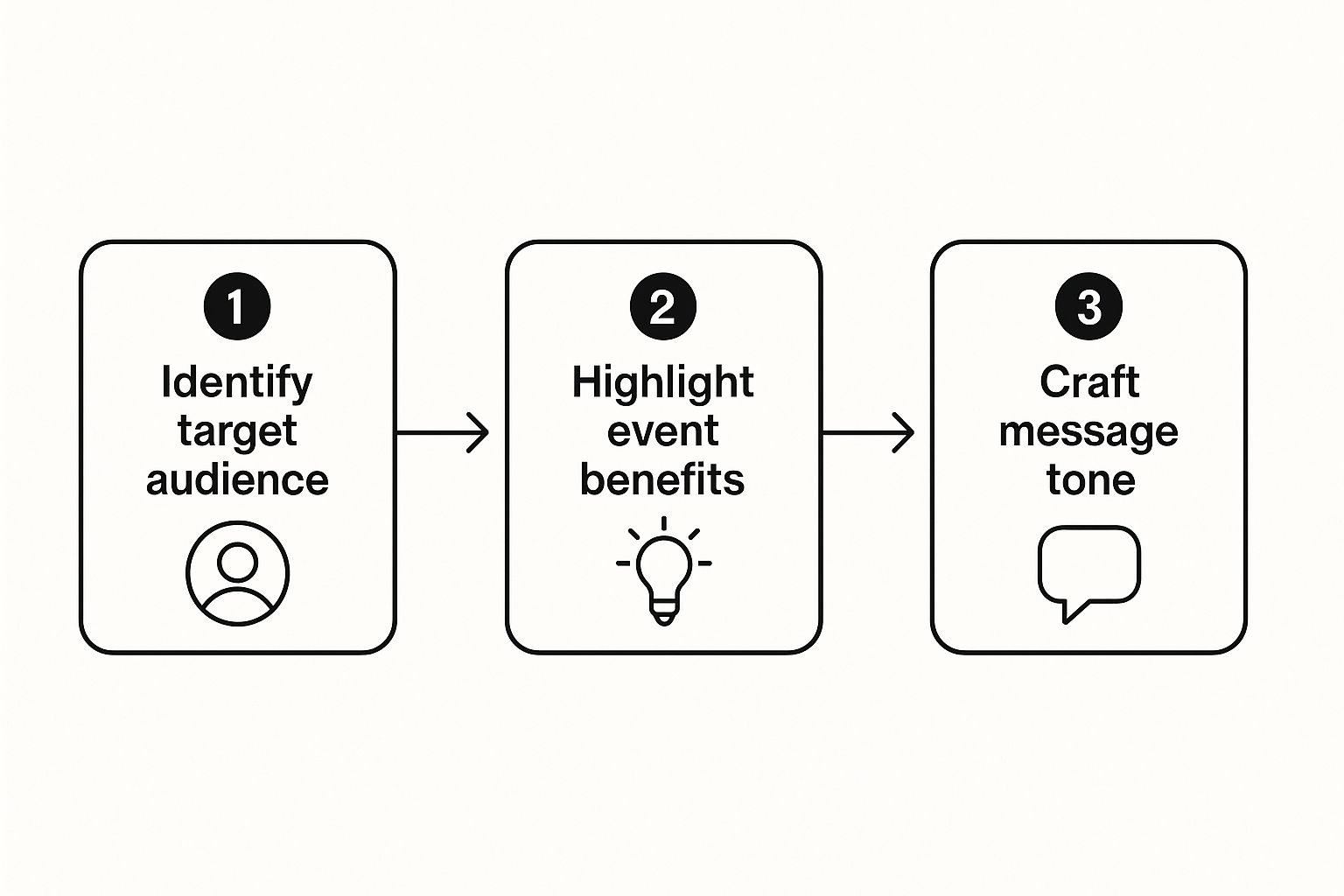
As you can see, it's a simple but powerful flow: understand the person first, then connect your event's benefits directly to what they need.
Once you’ve locked in your messaging, every single piece of your promotion becomes sharper and more effective. Your ads hit harder, your social posts get more engagement, and your emails actually get read. To keep it all straight, I highly recommend mapping everything out with a social media content calendar.
Creating a High-Converting Event Landing Page
Think of your event landing page as your digital box office. Its one and only job is to convert curious visitors into registered attendees. A weak page just lists facts; a great page inspires action. It needs to look good, be dead simple to use, and scream credibility from the rooftops.
Here’s a quick rundown of what I’ve found makes a landing page truly effective:
- A Killer Headline: Don't just announce the event. Sell the outcome. Instead of "Marketing Conference 2024," try something like "The Conference Proven to Triple Your Marketing ROI in 2024." See the difference?
- Compelling Visuals: Show, don't just tell. Use high-energy photos or a sizzle reel from past events. For a first-time event, professional headshots of your speakers or sharp graphics work wonders.
- Clear Value Proposition: Answer these questions immediately: Who is this for? What will they get out of it? Why is it a can't-miss opportunity?
- Social Proof: Nothing builds trust faster. Add testimonials from past attendees, logos of sponsors, or powerful quotes from your key speakers. Remember, nearly 90% of consumers trust online reviews as much as a friend's recommendation.
- An Obvious Call-to-Action (CTA): Make it impossible to miss. Use bold, contrasting colors for your buttons with action-focused text like "Reserve My Spot" or "Claim My Early Bird Ticket."
To make sure you've covered all your bases, I've put together a quick checklist. Run through this before you push your page live.
Essential Landing Page Elements Checklist
| Element | Purpose | Pro Tip |
|---|---|---|
| Headline | Grab attention and communicate the main benefit instantly. | Frame it as a solution to a problem your audience has. |
| Hero Image/Video | Create an emotional connection and show the event's vibe. | Use a high-quality, professional video from a previous event if possible. |
| Value Proposition | Clearly explain what the event is and why it's valuable. | Use bullet points to make the key benefits easily scannable. |
| Speaker/Guest List | Build credibility and showcase the expertise on offer. | Include headshots, titles, and a brief, impressive bio for each. |
| Event Details (Who, What, Where, When) | Provide essential logistical information upfront. | Add an "Add to Calendar" button to make it easy for registrants. |
| Social Proof (Testimonials, Logos) | Build trust and reduce hesitation. | Video testimonials are incredibly powerful if you can get them. |
| Clear Call-to-Action (CTA) | Guide the visitor to the next step (registration). | Use action-oriented language like "Register Now" or "Save Your Seat." |
| FAQ Section | Address common questions and overcome objections. | Think about what might stop someone from registering and answer it here. |
This checklist isn't just about ticking boxes; it's about building a seamless and persuasive experience for your visitor from the moment they land on the page.
Your landing page isn't just a flyer; it's a sales tool. Every element should work together to build excitement and eliminate friction, making the decision to register an easy one for your ideal attendee.
Mastering Digital Channels for Maximum Reach
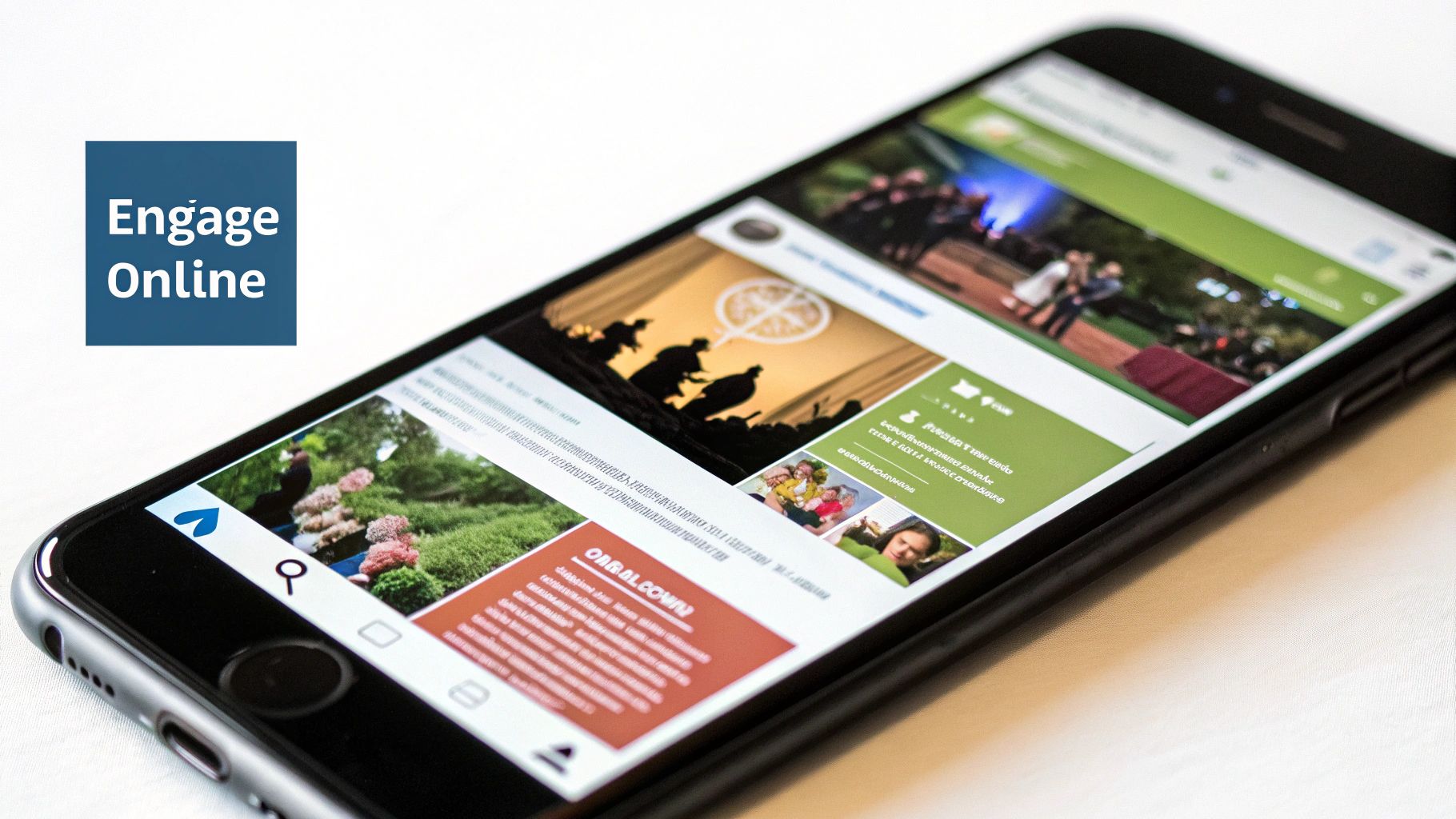
A solid digital game plan is the engine that drives modern event promotion. You can't just post an announcement online and hope for the best anymore. To really get noticed, you need to show up where your audience already hangs out, delivering the right message on the right platform at the right time.
It’s less about shouting into the void and more about starting conversations and building a real community. Consider that 35% of events are now fully virtual, with another 5% going hybrid. Your digital promotion has to connect with everyone, whether they’re in the room or on a screen. With 97% of marketers anticipating more hybrid events, a smart digital strategy is no longer optional.
Put Your Social Media to Work
Think of social media as more than just a place to post updates—it’s a powerful tool for building buzz. Every platform has its own vibe and audience, so copying and pasting the same message everywhere just won't work.
You have to play to each platform's strengths. For a platform like Instagram, lean into its visual appeal. Use Instagram Stories to share candid, behind-the-scenes snaps of the venue setup or a speaker getting prepped. Those little, authentic moments make people feel included and create a sense of urgency.
The best social media strategies make your audience feel like they're part of an inner circle. Give them sneak peeks, run polls about which session topic they're most excited about, and share photos or posts from past attendees to build a real sense of community.
LinkedIn, on the other hand, is your go-to for professional events. Set up a LinkedIn Event page to give attendees a dedicated space to connect beforehand. You can get conversations going by sharing articles from your keynote speaker or asking thought-provoking questions about your event's main theme. Many of the same principles for building a following apply across platforms, which you can read about in this guide on how to grow Instagram followers.
Use Email to Build Relationships
Don't sleep on email. It’s still one of the most effective ways to promote an event because it gives you a direct line to your audience. A well-planned email sequence can gently guide someone from being vaguely interested to eagerly hitting the "register" button.
Think of your email campaign as telling a story over time.
- The Big Reveal: Kick things off with an exciting announcement. Clearly state your event's value, name-drop a few key speakers, and push a strong call-to-action for early-bird pricing.
- The Value-Add: Over the next few weeks, send emails that offer genuine value. You could spotlight a specific speaker, break down the unique networking opportunities, or share glowing testimonials from last year.
- The Final Push: As the event gets closer, it's time to create a little friendly urgency. Send out "last chance" reminders, flag an upcoming price increase, and share the final schedule to get anyone who's been on the fence to commit.
Make sure every email has one clear goal. Trying to cram everything into a single message is a recipe for getting ignored. A focused email that highlights one killer benefit will always outperform a cluttered newsletter.
Create Content That Pulls People In
Content marketing is your long game. It's how you build authority, show up in search results, and create valuable assets you can repurpose across all your other marketing channels.
A great place to start is with blog posts that touch on your event's theme. For instance, if you're hosting a conference for marketers, you could publish a deep-dive article on "The 10 Marketing Trends You Can't Ignore in 2024," and feature a quote or insight from one of your speakers.
This strategy works on multiple levels:
- It gives your target audience genuinely useful information.
- It promotes your speakers and builds credibility for your event.
- It helps you rank for relevant keywords, attracting potential attendees through organic search.
By consistently creating content people actually want to read and share, you position your event as more than just a date on the calendar—it becomes a trusted hub for industry knowledge.
Tapping Into Partnerships and Your Community
Trying to promote an event all by yourself is a tough uphill battle. The truth is, some of the best marketing you can do involves getting other people to talk about your event for you.
When you build the right partnerships, you get to tap into networks that are way bigger than your own. This creates a powerful ripple effect, building buzz and credibility that you just can't buy with ads. It's all about finding those win-win situations where everyone benefits.
Find and Connect With the Right Partners
The whole game here is finding the right fit. Don't waste your time just blasting out emails to anyone with a decent-sized following. You need to be thoughtful about who your target audience already knows, likes, and trusts.
Your list of potential partners is probably bigger than you think.
- Industry Influencers: Find the creators and experts whose content directly relates to your event's topic. A genuine shout-out from one of them can be gold.
- Complementary Businesses: Hosting a local food festival? Team up with nearby breweries or kitchen supply stores. You can offer their customers a discount, and they can promote the event to their loyal base.
- Media and Bloggers: Local news, industry magazines, and popular bloggers are always on the hunt for a good story. A personal email or a well-crafted press release can get you some amazing free coverage.
- Sponsors: Remember, your sponsors are more than just a logo on a poster. They are your partners. They want the event to be a hit, so don't be shy about asking them to promote it through their own marketing channels.
When you reach out, lead with what's in it for them. Don't just ask for a favor. Offer them a unique discount code for their audience, a speaking slot, or prime logo placement. Make it an offer they can't refuse.
Turn Your Insiders Into Event Ambassadors
Your own speakers, sponsors, and even the first people who bought tickets can become your most powerful promoters. The trick is to make it dead simple for them to share. Nobody has time to write the perfect social media post for someone else’s event from scratch.
This is where an event media kit becomes your best friend. It removes all the guesswork and gives your partners the tools they need to start promoting right away. If you want to see what a great one looks like, check out these real-world influencer media kit examples.
Make sure your kit is packed with everything they need.
- Ready-Made Social Posts: Write a few different posts for platforms like LinkedIn, Instagram, and X. Be sure to include your event hashtag and a direct link to the ticket page.
- Sharp Graphics: Provide a handful of professionally designed images in different sizes—for stories, feed posts, and email banners. They should clearly show the date, location, and a catchy headline.
- Key Talking Points: A simple one-pager with the event’s mission, key dates, and essential details ensures everyone is sending a clear and consistent message.
By giving your network these simple tools, you're not just asking for help; you're building an authentic, word-of-mouth marketing engine that feels natural and trustworthy.
Creative Mid-Campaign and Offline Promotion Tactics
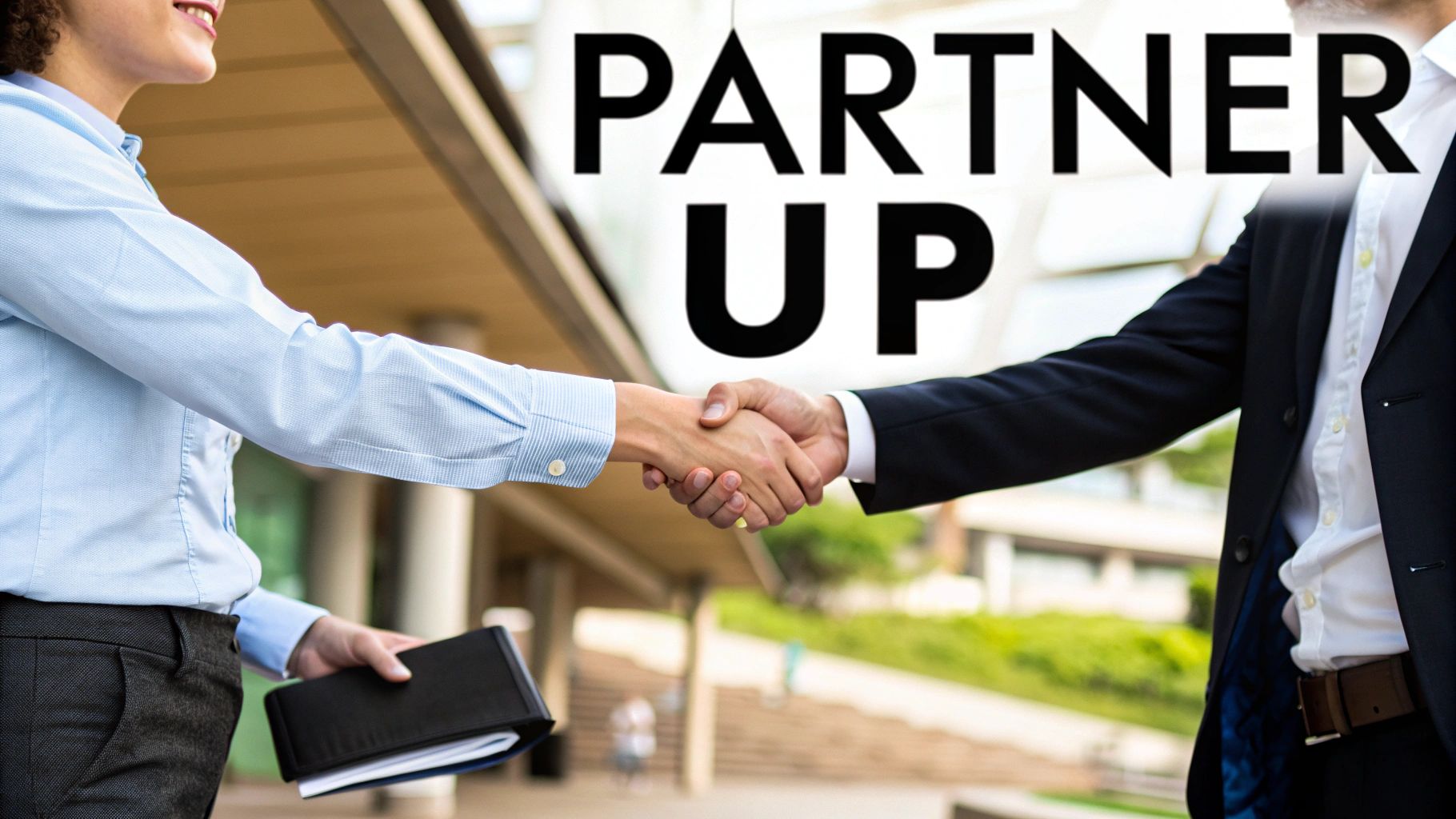
As your event gets closer, it's natural for that initial launch excitement to die down a bit. This is the critical moment to give your campaign a fresh shot of energy. You need to grab the attention of everyone who has been thinking about attending but hasn't committed yet.
This is where a well-timed reveal can be your secret weapon. Think about announcing a surprise guest speaker or a special performance to get people talking again. Even a simple 24-hour flash sale can create just enough urgency to nudge those on-the-fence folks to finally hit "register."
Bridge the Digital and Physical Worlds
While your online promotion is humming along, don't forget about the real world. Stepping offline helps you cut through the digital clutter and connect with people where they live, work, and hang out. A truly great campaign blends both.
Get into the mindset of your ideal attendee. Where do they go? What do they do?
- Local Business Partnerships: Let's say you're hosting a creative writing workshop. You could design some beautiful flyers and leave them at local coffee shops and indie bookstores. To sweeten the deal, offer the business owner a free ticket or a small commission for any sign-ups they send your way.
- Community Hubs: Classic community bulletin boards are still surprisingly effective. Think libraries, co-working spaces, and community centers—places where people are actively looking for new things to do.
- Local Media: Don't dismiss the power of local media. A quick interview on a popular local podcast or a short feature in the community newspaper can lend your event a ton of credibility and reach an entirely new audience.
This is also a fantastic opportunity to flex your creative muscles with design. The same principles that make for great online visuals often work for print, too. Our guide on how to create engaging social media content has plenty of ideas that translate well to physical media.
An eye-catching flyer in a coffee shop can sometimes be more impactful than a hundred targeted ads. It feels personal and authentic, creating a different kind of connection with your potential audience.
Create Mid-Campaign Talking Points
Your promotion should never feel static. You need to keep the conversation alive by dropping new information and giving people fresh reasons to talk about your event. This is how you maintain momentum.
A countdown is a classic for a reason—it works. Start a daily countdown on your social media channels. Each day, you can highlight a different speaker, a specific session, or a unique feature of the event. It’s a simple, non-intrusive way to build anticipation and stay top-of-mind.
For instance, if you're promoting a food festival, a week out you could post: "Only 5 days left! Get a sneak peek at the secret menu item from [Vendor Name]!" This kind of post not only builds hype for your event but also gives some love to your partners. The goal is to keep your campaign feeling dynamic and exciting, right up until the doors open.
Got Questions About Promoting Your Event? We've Got Answers.
Even the most seasoned event marketer runs into a few head-scratchers along the way. Planning and promoting an event is a complex dance, so it's only natural to have questions. Let's walk through some of the most common challenges I see and break them down with some straightforward, practical advice.
How Far in Advance Should I Start Promoting My Event?
This is the classic "how long is a piece of string?" question, but there are some solid guidelines you can follow. The key is to think about your audience and work backward from the event date.
For big-ticket events like a multi-day conference or a major festival, you need to be in the market 4-6 months ahead of time. People often need to book flights, arrange hotels, and get time off work, so giving them a long runway is non-negotiable.
But if you're promoting a local workshop, a webinar, or a community meetup, starting 6-8 weeks out is usually the sweet spot. It gives you enough time to build genuine buzz without your audience getting tired of hearing about it.
What's the Best Way to Know if My Promotion is Actually Working?
Ticket sales are the obvious metric, but they don't tell the whole story. To really understand what's working (and what's not), you need to look a little deeper.
I always recommend focusing on a handful of key metrics:
- Landing Page Conversion Rates: Of all the people hitting your registration page, what percentage is actually signing up? This tells you if your page is compelling.
- Traffic Sources: Get comfortable with UTM codes. They are your best friend for figuring out if your traffic is coming from your email list, social media posts, or paid ads.
- Cost Per Acquisition (CPA): If you're running paid campaigns, you absolutely must know how much you're spending to get each butt in a seat.
Here's a pro tip: Don't forget the power of asking. A simple post-event survey with the question, "How did you hear about us?" can uncover gold for your next event's strategy.
Help! My Ticket Sales Have Completely Stalled.
First off, take a breath. A mid-campaign sales slump happens to almost everyone. It’s not a sign of failure; it’s a sign you need to shake things up and give people a fresh reason to pay attention.
When momentum flatlines, it's time to inject some urgency. A 24-hour flash sale with a modest discount can work wonders. Another go-to tactic is to announce a new surprise—maybe a last-minute keynote speaker or an exclusive networking session. You could also run a social media giveaway for a free ticket or share some compelling behind-the-scenes video to get people talking again.
How Can I Promote an Event When I Have Almost No Budget?
You don't need a Fortune 500 budget to make a big splash. When money is tight, you just have to get scrappy and lean into your community.
Your biggest allies are often your speakers, sponsors, and partners. They have their own audiences who already trust them. Put together a simple media kit for them—we're talking pre-written social posts, a few nice graphics, and the event hashtag. Making it ridiculously easy for them to share is one of the most powerful (and free) marketing moves you can make. It builds authentic word-of-mouth that money just can't buy.
Ready to create stunning visuals for your event promotions without the hassle of a photoshoot? With YourAIPhotographer, you can generate photorealistic images in seconds. Train your own AI model and create endless professional-grade photos for your speakers, marketing materials, and social media campaigns.
